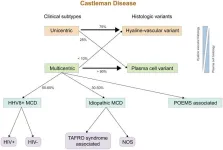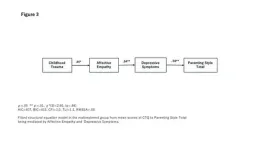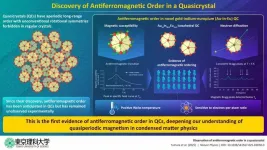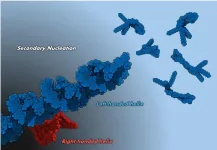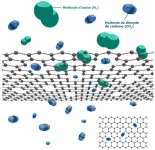(Press-News.org) The University of Virginia has named Mark T. Esser, PhD, a premier expert in the development of new medical treatments and tests, to lead the upcoming Paul and Diane Manning Institute of Biotechnology and bring to life the institute’s ambitious plans for a healthier tomorrow for people across the world.
In his role as the inaugural chief scientific officer and head of the Manning Institute, Esser will be charged with capitalizing on the cutting-edge biomedical research under way at UVA and UVA Health to tackle some of the greatest challenges in medicine and accelerate the development of new treatments and cures.
In addition to an extremely generous $100 million donation from philanthropists Paul and Diane Manning, the institute is being funded by a substantial investment of $100 million to date from the Commonwealth of Virginia and $150 million from UVA – for a total initial investment of $350 million – signaling strong recognition of the institute’s potential both to transform healthcare and to serve as an economic powerhouse for the state. One of Esser’s responsibilities will be to foster an “ecosystem of innovation” that will attract biotechnology and pharmaceutical companies to Central Virginia and the greater Commonwealth, bringing with them hundreds of jobs directly and potentially thousands indirectly.
“We are fortunate to have found an ideal candidate in Dr. Mark Esser to lead the Manning Institute,” UVA President James E. Ryan said. “He brings both great scientific expertise and decades of experience in developing new treatments and medical breakthroughs. He is a bridge-builder who knows how to work collaboratively, how to work efficiently and how to get things done. He will be the lynchpin in realizing the potential of the Manning Institute to shape the future of medicine.”
The 350,000-square-foot Manning Institute is already under construction in Fontaine Research Park. Once complete, the four-story building will bring high-tech research facilities, state-of-the-art manufacturing capabilities and welcoming patient care space together under one roof. At the same time, UVA is developing a statewide clinical trials network that will expand access to new treatments as they are being developed and tested.
“Dr. Esser is a perfect choice to lead the Manning Institute – and UVA – to the very forefront of cutting-edge medicine,” said Brie Gertler, who oversees the University’s teaching and research activities as interim executive vice president and provost. “He brings the multi-faceted expertise and far-reaching skills that will be essential in fast-tracking exciting ideas into lifesaving and life-changing treatments.”
Esser comes to UVA from research-based biopharmaceutical company AstraZeneca, where he is vice president for vaccines and immune therapies. In his roles there, he has overseen research and development programs from concept through approval. He also has served as a global product development lead.
His appointment as the Manning Institute’s head marks a homecoming: he obtained his PhD in microbiology from UVA School of Medicine in 1998.
“I’m excited not just to return to UVA but to lead it into a new era of biomedical research,” Esser said. “The Manning Institute represents an unprecedented opportunity both for me, personally, and for the entire field of healthcare. I know the incredible caliber of talent UVA attracts, and I can’t wait to work with many of the top minds in medicine to make a real difference in the lives of people around the world.”
Esser’s skills include immunology (the study of the immune system), vaccines and biologic drugs, virology and microbiology, diagnostics and biomarkers, clinical research and development, business development and navigating federal research regulations and submissions.
“Dr. Esser is a preeminent scientist, with a deep understanding of medical research, who understands how to quickly and safely advance discoveries from the lab bench to the bedside,” said Mitchell H. Rosner, MD, UVA’s acting executive vice president for health affairs. “Our goals for the Manning Institute are to accelerate how quickly we can get new treatments to patients and to ensure that no Virginian has to leave the state for even the most complex care. Dr. Esser has the vision and experience to deliver on both of those.”
In his role at AstraZeneca, Esser collaborates closely with business partners, academic researchers and government officials – experience that will prove invaluable as he helps UVA navigate the complex regulatory requirements and contractual relationships needed to bring new treatments to the clinic. While at AstraZeneca, he has provided leadership and guidance for more than 20 drug discovery, clinical and post-marketing biological drug and vaccine programs. He oversees a staff of 100 and manages an annual budget of more than $30 million.
Further, he is an accomplished scientist himself, holding numerous patents and having published more than 130 peer-reviewed papers. Prior to assuming his current post, he worked as a senior director overseeing clinical immunology, microbiology and diagnostics for infection and cancer vaccine programs for MedImmune/AstraZeneca. In that role, he led global product development for Evusheld, a medicine that received emergency authorization for the prevention and treatment of COVID-19 during the pandemic. In addition, Esser also was pivotal in the development of Beyfortus® (niresevimab), a monoclonal antibody approved for the prevention of respiratory syncytial virus (RSV) in infants.
His earlier work included developing biomarker and diagnostic strategies for vaccines against Epstein-Barr virus, human papillomavirus (HPV), hepatitis B, pandemic influenza and dangerous infections such as S. aureus, P. aeruginosa and C. difficile.
Prior to joining AstraZeneca, he was a senior research fellow and senior research immunologist at Merck Research Laboratories. He did his postdoctoral fellowship with the National Institutes of Health’s AIDS vaccine program after obtaining his PhD at UVA and his undergraduate degree from Case Western Reserve University.
“Mark Esser is the complete package – a smart, savvy and experienced leader with broad knowledge and a proven track record of success,” said Paul Manning, a longtime healthcare entrepreneur who now chairs UVA’s Heath System Board. “I am confident he will make the Manning Institute a game-changing force in medicine, to the benefit of patients across Virginia and beyond.”
To keep up with the latest medical research news from UVA, subscribe to the Making of Medicine blog.
END
Top medical research expert Mark T. Esser named inaugural head of UVA’s Manning Institute
Upcoming institute aims to transform healthcare, accelerate new treatments
2025-04-11
ELSE PRESS RELEASES FROM THIS DATE:
Protein GSK3β offers new angle on overcoming melanoma drug resistance
2025-04-11
“Inhibitors of GSK3β reduce the cell viability of BRAFi-resistant melanoma cell lines and thus may holds promise as a novel strategy to overcome BRAFi resistance and melanoma progression.”
BUFFALO, NY – April 11, 2025 – A new research perspective was published in Oncotarget, Volume 16, on April 4, 2025, titled “GSK3β activation is a key driver of resistance to Raf inhibition in BRAF mutant melanoma cells.”
In this work, first author Diana Crisan and corresponding author Abhijit Basu from the University Hospital Ulm led ...
Mimickers and associated neoplasms of Castleman disease
2025-04-11
Castleman disease (CD) is a rare, non-clonal lymphoproliferative disorder that manifests with a wide range of histologic and clinical features. It is classified clinically into unicentric (UCD) and multicentric (MCD) forms and histopathologically into hyaline vascular (HV-CD), plasma cell (PC-CD), and mixed types. UCD typically presents as an isolated lymph node enlargement, often asymptomatic, whereas MCD involves multiple nodal sites and systemic symptoms. MCD may be associated with human herpesvirus 8 (HHV8), idiopathic origins (iMCD), POEMS syndrome, or TAFRO ...
Preserving and using the deep sea: scientists call for more knowledge to enable sustainable management
2025-04-11
Where does the deep sea begin? Definitions vary across science and legal frameworks. For the purposes of their joint analysis, the members of the European Marine Board’s (EMB) Deep Sea and Ocean Health Working Group defined the deep sea as the water column and seabed below 200 metres. Below this point, sunlight barely penetrates the water, and the habitat changes dramatically. According to this definition, the deep sea accounts for about 90 per cent of the ocean’s volume. Its importance for ...
Breaking the cycle: unveiling how childhood trauma fuels parenting and abuse
2025-04-11
Childhood maltreatment (CM) is a complex issue that is often passed on through generations. Studies have shown that parents who were abused as children may perpetuate a similar pattern of mistreating their children, creating a vicious cycle of abuse. A key factor in perpetuating this cycle is impaired empathy in parents who grew up in abusive environments. Simply put, parental empathy, the ability to understand and respond to children’s emotions, plays a critical role in effective parenting. In fact, children who experience abuse tend to have reduced empathy by the age ...
A new era in materials science: antiferromagnetic quasicrystals unveiled
2025-04-11
Quasicrystals (QCs) are fascinating solid materials that exhibit an intriguing atomic arrangement. Unlike regular crystals, in which atomic arrangements have an ordered repeating pattern, QCs display long-range atomic order that is not periodic. Due to this ‘quasiperiodic’ nature, QCs have unconventional symmetries that are absent in conventional crystals. Since their Nobel Prize-winning discovery, condensed matter physics researchers have dedicated immense attention towards QCs, attempting to both realize their unique quasiperiodic magnetic order and ...
From boring to bursting: a giant black hole awakens
2025-04-11
Although we know that supermassive black holes (millions of times the mass of our Sun) lurk at the centre of most galaxies, their very nature makes them difficult to spot and study. In contrast to the popular idea of black holes constantly ‘gobbling up’ matter, these gravitational monsters can spend long periods of time in a dormant, inactive phase.
This was true of the black hole at the heart of SDSS1335+0728, a distant and unremarkable galaxy 300 million light-years away in the constellation of Virgo. After being inactive for decades, it suddenly lit up and recently began producing unprecedented flashes of X-ray light.
The first signs ...
Illuminating the twist: light-driven inversion of supramolecular chirality
2025-04-11
Self-assembly or self-organization in molecular science refers to the phenomena where molecules spontaneously gather and form ordered structures, a unique property of materials used to develop optical and electronic materials. In a step towards fine-tuning this property, researchers from Japan successfully elucidated a technique where a small amount of residual aggregates drastically altered the self-assembly process of photo-responsive molecules. The research team was led by Professor Shiki Yagai from the Graduate School of Engineering, Chiba University, including Assistant Professor ...
Engineered bacteria emit signals that can be spotted from a distance
2025-04-11
CAMBRIDGE, MA -- Bacteria can be engineered to sense a variety of molecules, such as pollutants or soil nutrients. In most cases, however, these signals can only be detected by looking at the cells under a microscope or similarly sensitive lab equipment, making them impractical for large-scale use.
Using a new method that triggers cells to produce molecules that generate unique combinations of color, MIT engineers have shown that they can read out these bacterial signals from as far as 90 meters away. Their work could lead to the development of bacterial sensors for agricultural and other applications, which could be monitored by drones or ...
Scalable graphene membranes: a leap for carbon capture
2025-04-11
Capturing carbon dioxide (CO₂) from industrial emissions is crucial in the fight against climate change. But current methods, like chemical absorption, are expensive and energy-intensive. Scientists have long eyed graphene—an atom-thin, ultra-strong material—as a promising alternative for gas separation, but making large-area, efficient graphene membranes has been a challenge.
Now, a team at EPFL, led by Professor Kumar Agrawal, has developed a scalable technique to create porous graphene membranes ...
Early detection of Parkinson’s with novel RNA-based blood test
2025-04-11
Researchers have developed a simple and cost-effective blood test capable of detecting Parkinson’s disease long before symptoms emerge, comparing the current state of diagnosing neurodegenerative diseases to the fight against cancer 50 years ago—when most cases were identified too late for effective treatment. The test quantifies specific RNA fragments in the blood, focusing on a repetitive RNA sequence that accumulates in Parkinson’s patients and a parallel decline in mitochondrial RNA, which deteriorates as the disease progresses. By measuring the ratio between these biomarkers, the test offers a highly accurate, non-invasive, rapid and affordable diagnostic tool, ...
LAST 30 PRESS RELEASES:
Phonetic or morpholexical issues? New study reveals L2 French ambiguity
Seeing inside smart gels: scientists capture dynamic behavior under stress
Korea University researchers create hydrogel platform for high-throughput extracellular vesicle isolation
Pusan National University researchers identify the brain enzyme that drives nicotine addiction and smoking dependence
Pathway discovered to make the most common breast cancer tumor responsive to immunotherapy
Air pollution linked to more severe heart disease
Where the elements come from
From static papers to living models: turning limb development research into interactive science
Blink and you will miss it: Magnetism switching in antiferromagnets
What’s the best way to expand the US electricity grid?
Global sports industry holds untapped potential for wildlife conservation
USF-led study reveals dramatic decline in some historic sargassum populations
Fullerenes for finer detailed MRI scans
C-Compass: AI-based software maps proteins and lipids within cells
Turning team spirit into wildlife action
How influenza viruses enter our cells
New camera traps snap nearly three times more images of endangered Sumatran tigers than before
Survey: Nearly all Americans not aware midwives provide care beyond pregnancy, birth
Fearless frogs feast on deadly hornets
Fibulin-5: A potential marker for liver fibrosis detection
Development of 'OCTOID,' a soft robot that changes color and moves like an octopus
Marriage, emotional support may protect against obesity through brain-gut connection, study finds
High-speed all-optical neural networks empowered spatiotemporal mode multiplexing
High-energy-density barocaloric material could enable smaller, lighter solid-state cooling devices
Progresses on damped wave equations: Multi-wave Stability from partially degenerate flux
First discoveries from new Subaru Telescope program
Ultrafast laser shock straining in chiral chain 2D materials: Mold topology‑controlled anisotropic deformation
Socially aware AI helps autonomous vehicles weave through crowds without collisions
KAIST unveils cause of performance degradation in electric vehicle high-nickel batteries: "added with good intentions
New ECU tool can help concussion patients manage fear and improve recovery
[Press-News.org] Top medical research expert Mark T. Esser named inaugural head of UVA’s Manning InstituteUpcoming institute aims to transform healthcare, accelerate new treatments


